How much light do succulents need? This is a critically important question with a somewhat complicated answer. Succulent light needs vary widely by variety. Some need lots of bright sun for many hours every day, while others thrive in shadier environments. To further complicate the issue, “full sun” is far more intense just 15 miles east of where I’m typing than it is right here, and here is more intense than 6 miles west, on the coast. So around the world, the physical reality of “full sun” or “partial shade” must vary even further. So how can you possibly learn to get lighting for succulents right? Fortunately, the succulents themselves know exactly what they need and they’ll tell you! And I created an infographic to help you to understand how succulents respond to light and what it means.
<– Click the How Much Light do Succulents Need infographic, then click the magnifying glass icon for the best view!
Then, come back to read the rest of the post! 🙂
{Please note, some links in this post may be affiliate links to sites that pay me a small commission if you click on the link and make a purchase. This commission is at absolutely no cost to you. I only recommend products and companies that I have worked with and truly love! ~Kat}
Why do Succulents Need Sun?
In this Post We'll Cover:
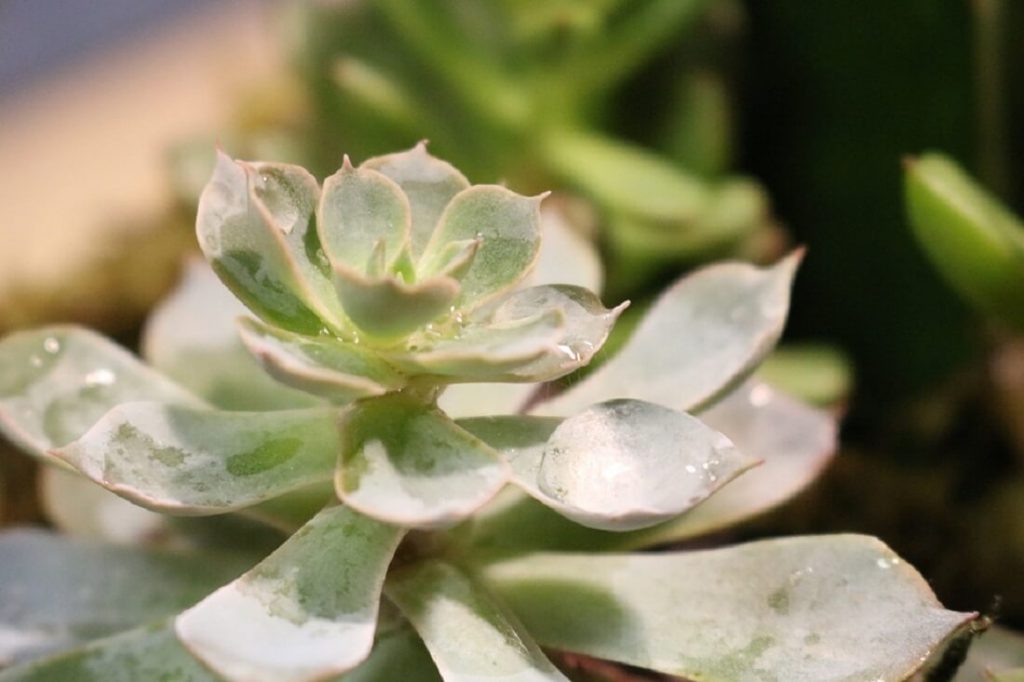
For every succulent, light is essential. Let’s start with the more fundamental question, why do succulents need sun light? The essential needs for plants in general and succulents, in particular, are light, air, water and nutrients, known by the acronym LAWN. In fact, the out-sized importance of succulent soil comes from its purpose to provide stable access to each of these essentials. All succulents need light for photosynthesisPhotosynthesis (FO-to-SIN-thuh-sis) is the process plants us... More. Photosynthesis is the process where plants convert sunlight, carbon dioxide and water into energy, releasing oxygen. Plants use the energy to build more plant, to grow, thrive and reproduce. Light is essential for plant life. Because plants are the foundation of any food chain, it can be said that all life on earth relies on light.
In nature, succulents rely on the sun to produce all the light they need. But succulents have evolved to grow and thrive in a wide range of climates and conditions, from bright, desert sun to dappled, rain forest shade. This is the reason some succulents need plenty of sun, while others are low-light succulents. It all comes back to the conditions they evolved to thrive in. A start to understanding how much light do succulents need is to mimic the conditions they are native to. This is how to get the right lighting for succulents.
If a plant does not get enough light, it will not be able to photosynthesize enough energy to grow properly and thrive. But if it gets too much light, a succulent can sunburn, which threatens its stores of moisture and impairs photosynthesis. You can see why succulents are invested in getting the lighting right. But even if you do know how much light your succulents need — how to adjust for the different nature of sunshine from one climate to another? Do you simply have to *know* that this succulent that thrives in full sun on the foggy coast of California will fry in the inland sun? Not at all. Your succulent will tell you.
How Much Light do Succulents Need? The Right Amount
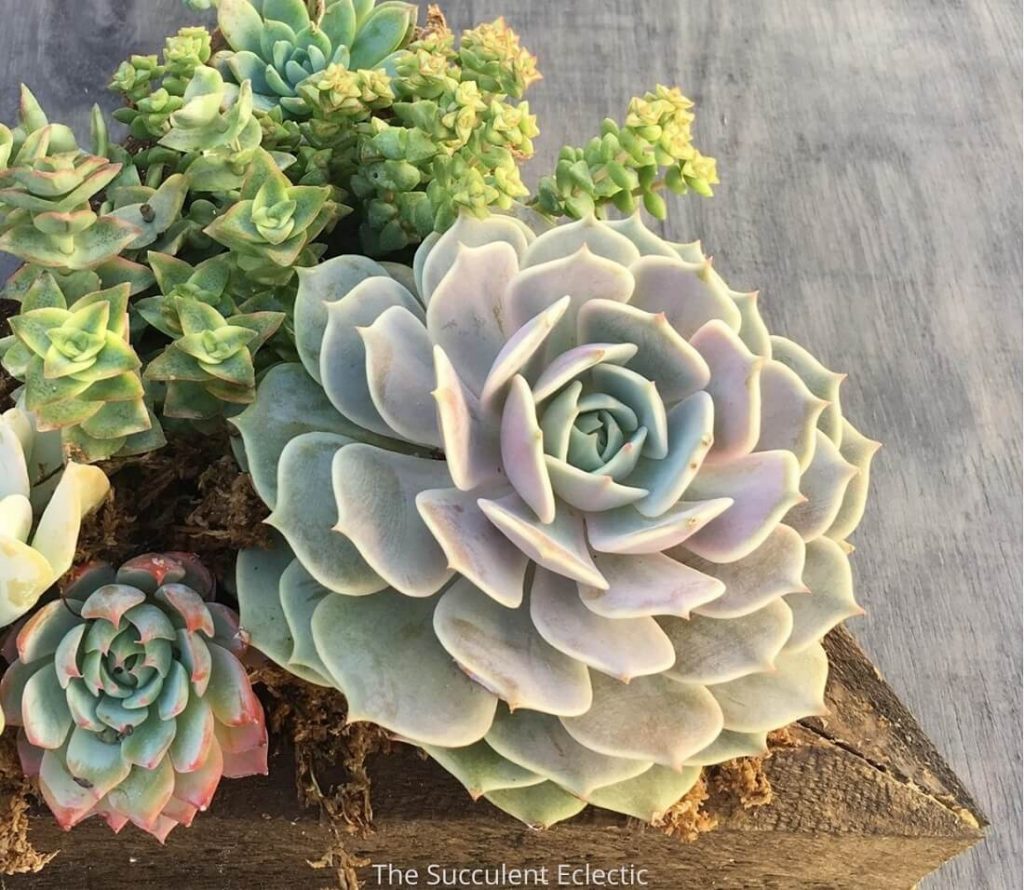
When my husband is getting me a bowl of ice cream or adding cream to my coffee, he always asks “How much do you want?” and I usually answer “the right amount”. While I’m sure you can see why he gets frustrated by this — I know you also know exactly what I mean, right? When you want something — you want “the right amount”. It can be difficult to describe in the moment, but it’s easy to recognize, isn’t it? The same is true with succulent light. How much light do succulents need? Every succulent plant “knows” how much light it needs, and it will respond to the light it gets in ways that will clearly tell you whether it needs more or less or is happy right where it is.
Above, you see my photo of an Echeveria ‘Lola’. It is in the classic, rosette succulent shape, with the layers of leaves growing close together, the center leaves a little more closed than those out to the side. This succulent is getting the “right amount” of light. It is fully satisfied, and neither wants more nor is it suffering from too much light. Consider this shape the “baseline” for rosette succulents growing in the right succulent light.
To illustrate this post on lighting for succulents in general, I am using Echeveria throughout, simply for greater clarity. All of the changes succulents make in response to light happen across all varieties. It’s just that some are easier to recognize than others. Start here, and study the infographic too. Continue to look at your succulents with these potential changes in mind. Identify your succulents and look them up online what your succulent is supposed to look like, and use that shape as the baseline for recognizing changes in response to light.
Succulents Stretching for More Light
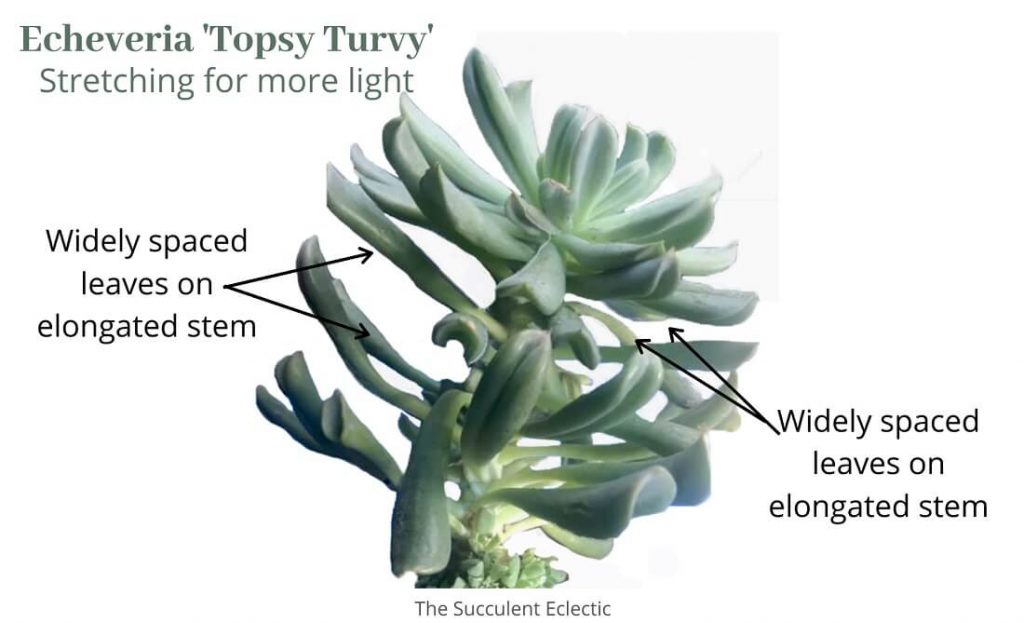
One way to answer the question How much light do succulents need, is “enough light to maintain a compact growth habit”. Succulent light is so important that plants without sufficient light will etiolate — stretching tall, reaching for the light they need. This great photo of Echeveria ‘Topsy Turvy’ is courtesy of Julie Kaye Dehne, and it demonstrates etiolation well. The plant normally makes the curled leaves you see here, but the plant should be much shorter, each layer of leaves should be close, and not spaced so far apart. Widely spaced rows of leaves are a clear sign that the succulent is stretching for more light. Stretching gets the plant closer to the source of light while also exposing lower leaves to more light.
Plants “know” that the sun is up in the sky. If they don’t have enough light, they will stretch, reaching high for the light they know must be up there somewhere. But when they sense a source of light, from a lamp, through a window, past a wall or tree, they will stretch toward that light. This is why succulents not only stretch tall but can lean way over.
Once succulents have stretched, you cannot change the shape of the plant. Moving it into more light won’t make it go back to normal. And be sure to increase light gradually, so the succulent can acclimate to the greater light without burning. But with sufficient lighting for succulents, the new growth will emerge compact, as it should be. EtiolatedA plant is etiolated (EE-tee-oh-late-ed) when it grows very ... succulents should be cut back, with the top treated as a stem cutting and re-rooted. Continue to care for the rooted base, and it will likely produce new, compact top growth for you.
Succulent Leaves Pointing Down
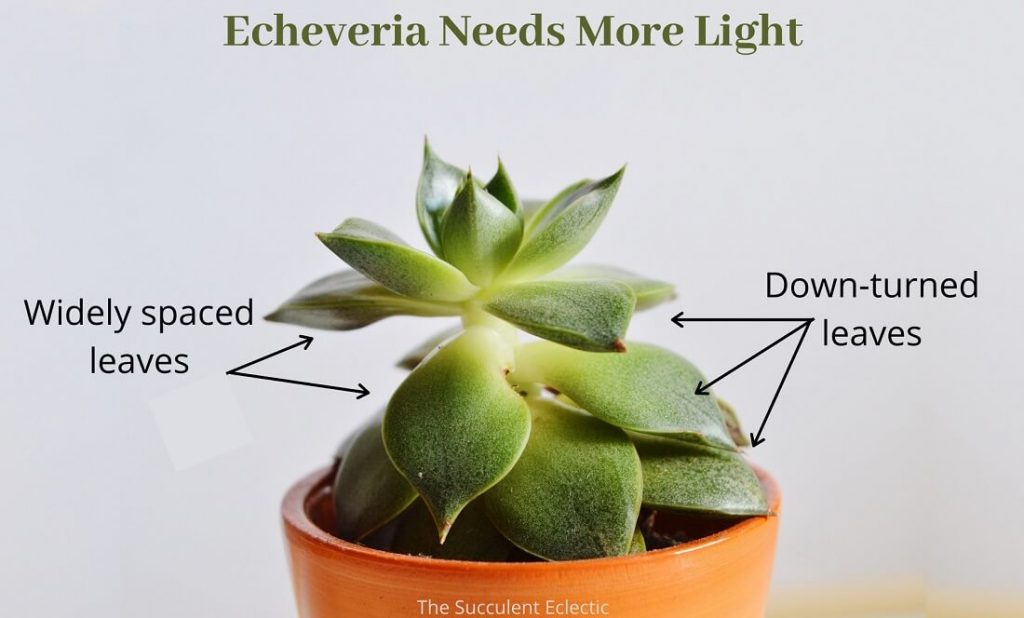
When succulents need more light, they may point their leaves down, to maximize the surface area of each leaf exposed to the available light. It enables the plant to make the most of the succulent light that’s available. It’s important to recognize that a succulent “intentionally” pointing its leaves down is not the same as a succulent whose leaves are drooping. The difference is very clear to the touch. If you gently lift up the point of the leaf and it moves easily, the succulent is drooping. This issue has nothing to do with the lighting, and we’ll cover it in another post. But if the leaf is held rigidly in place, resisting your lifting touch, it is pointing down specifically to access more light.
Unlike etiolation, a succulent’s leaves pointing down can be reversed. If you have a succulent pointing its leaves down and move it into more light, the plant can and will change the leaf position back to normal. Pointing or tilting its leaves up, down or out to the side in response to the available sunlight is one of many adaptations succulents have made to thrive in challenging conditions. Pay attention — these leaf movements are excellent signals about your succulent’s health that let you know how your lighting for succulents is going.
When you notice your succulent leaves drooping or pointing down, first determine which it is. Lift up on the tips to learn whether the plant is wilting or deliberately turning its leaves down to catch more light. If it’s clear you need better lighting for the succulents, increase the succulent light gradually, so the plant can acclimate. Never take a succulent that’s been growing indoors or in a shady spot for a while and move it in right into full sun. It takes time for succulents to build up a tolerance to increased sunlight — just as it takes us a while to build up a protective suntan. Biologically, the processes are very similar. Increase light gradually so the succulent can acclimate fully.
Succulent Leaves Closing Up
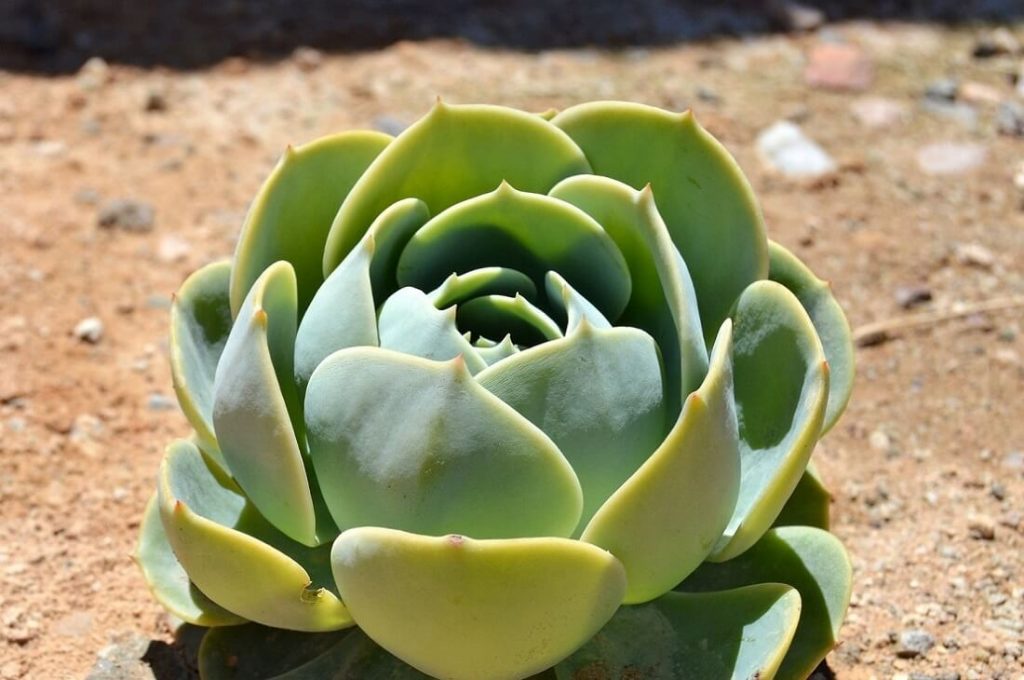
Just as succulents can point their leaves down to access more sunlight, you’ll also see succulent leaves closing up in response to intense light. While this cannot save a succulent from sunburn, pointing its leaves up shades neighboring leaves, giving them a respite from intense light and heat.
Do not rely on succulents pointing their leaves up to judge whether it may sunburn. Generally, sunburn happens more quickly than the plant can move. But when you see a succulent folding its leaves closed as much as it can, it is a clear indication that the succulent light is intense and uncomfortable. While this does indicate that the succulent is uncomfortable, it may not need to be remedied. The plant is taking care of itself.
See how the Echeveria above is much more closed up than the one we used as a baseline? It is responding to the intensity of the light by maximizing the shade it’s in, by using its leaves to shade other leaves. It may be perfectly fine to continue growing in this location. It may well open its leaves back to the baseline in early mornings and again in late afternoon. This is how succulents (and many other plants) have evolved to handle intense sun when they cannot seek out shade — they create it.
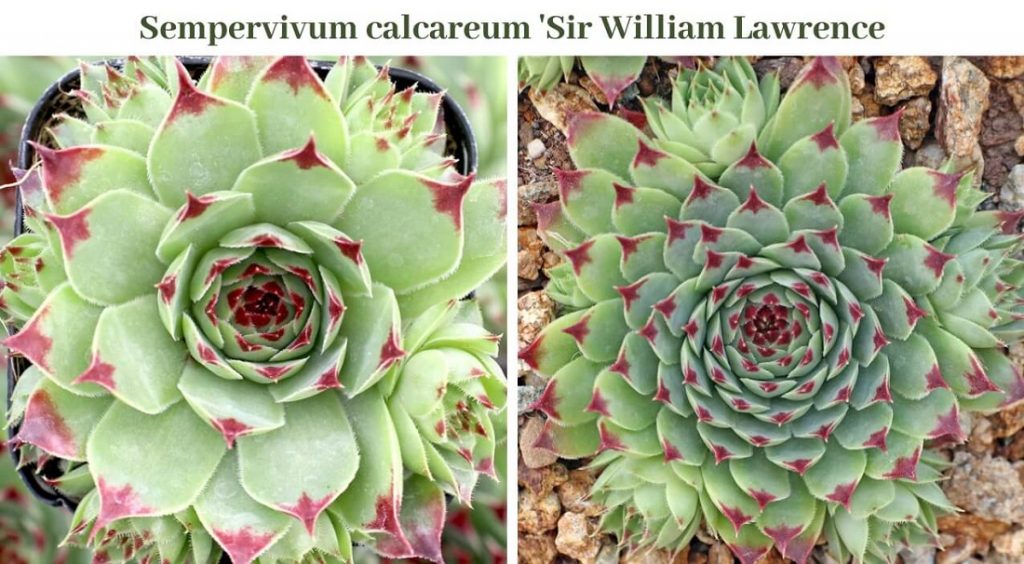
Some succulents, like the Echeveria above, open and close throughout the day in response to changes in lighting. Others, like Sempervivum, respond to the heat and high-intensity light of summer by closing up all season long. The Sempervivum calcareum ‘Sir William Lawrence’ above is wide open in spring, collecting all the sunshine it can. One of the ways it acclimates to the higher heat and intensity of light in summer is by folding its leaves and remaining contracted until the cooler temps of fall arrive, when it opens back up again.
Sunburned Succulents
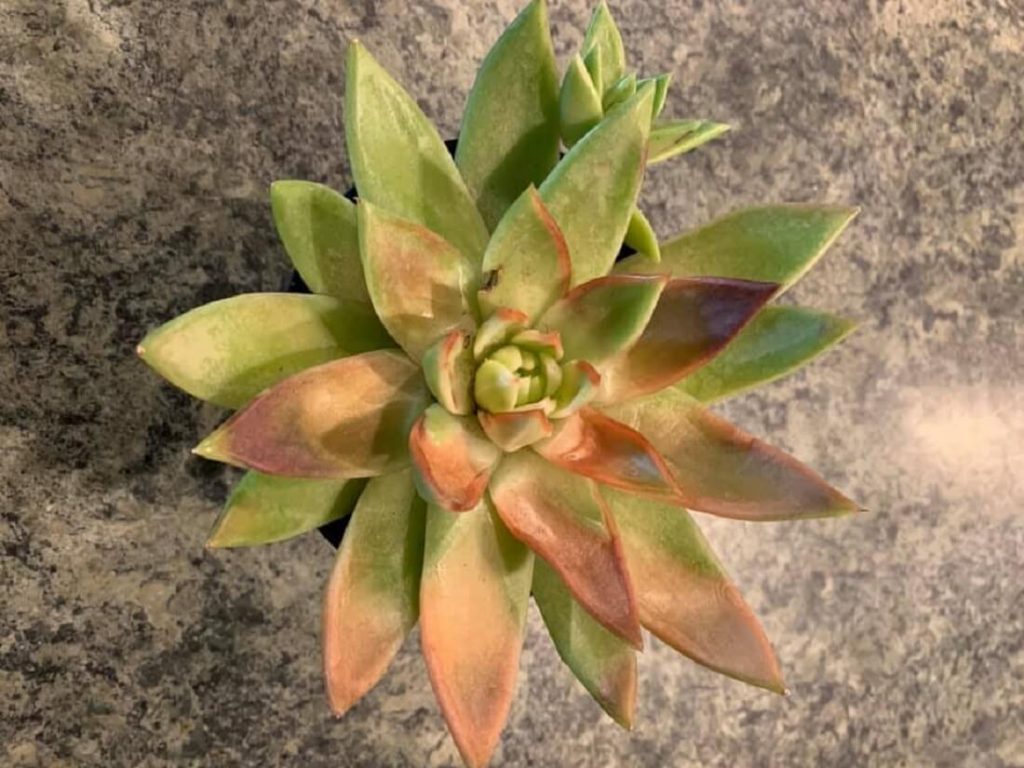
How much light do succulents need is a question best answered by making changes to the lighting and watching the succulent’s response as described above. However, if a succulent is placed in too much sun before it is fully acclimated, it may sunburn. Often, this happens when you first bring a succulent home from the nursery or receive it in the mail. Most large-scale succulent growers use shade cloth to optimize the lighting for their plants while protecting them from sunburn. If you take that protected plant and put it straight out into full sun, it will likely burn. Thank you, Jordan Bennet, for the use of this photo!
Even succulents that can thrive in direct sun for 8 hours a day must build up the protective pigments to be able to do so, gradually. These protective pigments are the secret to colorful succulents. Succulents have evolved to respond to climate changes that occur over seasons, not hours. All-day sun in early spring is much less intense than in the summer. Every day until mid-summer, the intensity grows slowly, allowing the plant to adapt. I recommend exposing your succulents to more sunlight, outdoors by 1/2 hour a day every 2-3 days. Keep watch on the plant to note whether it points its leaves down or begins to stretch, indicating that it needs more light. If it does, increase by 1/2 hour the next day. If, instead, it closes its leaves, indicating the light is quite intense, back off a bit on the light or wait a week before increasing it further.
How Much Light do Succulents Need Indoors?
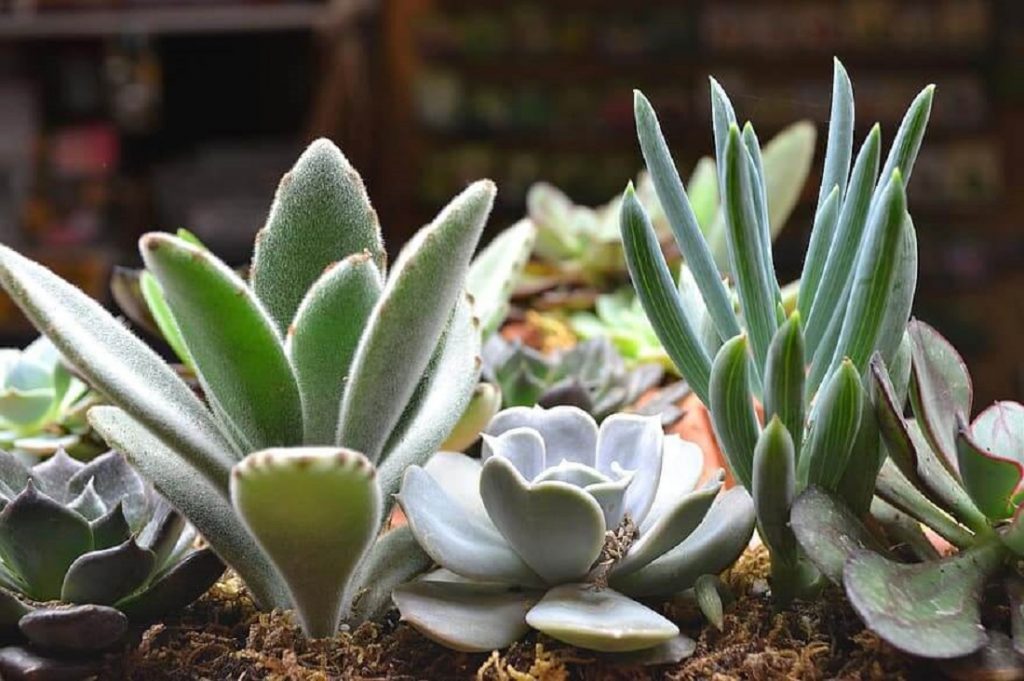
How much light do succulents need is an important question to answer, whether indoors or out. With winter fast approaching, many are bringing their succulents indoors to overwinter, protected from freezing. Most succulents that have grown well outdoors will stretch in response to the lower light available indoors. They will need grow lights in order to thrive indoors. Check out my simple guide to succulent grow lights, or skip straight to my recommended grow lights here.
Low light succulents like Haworthia, Sansevieria and specific varieties of other genera have evolved to thrive in circumstances where the sunlight was filtered through fog, trees and other natural obstacles that block the full force of the blazing sun. These are the varieties that are best suited to growing indoors, where lighting for succulents is necessarily restricted.
Ensuring Succulent Light is Just Right Outdoors
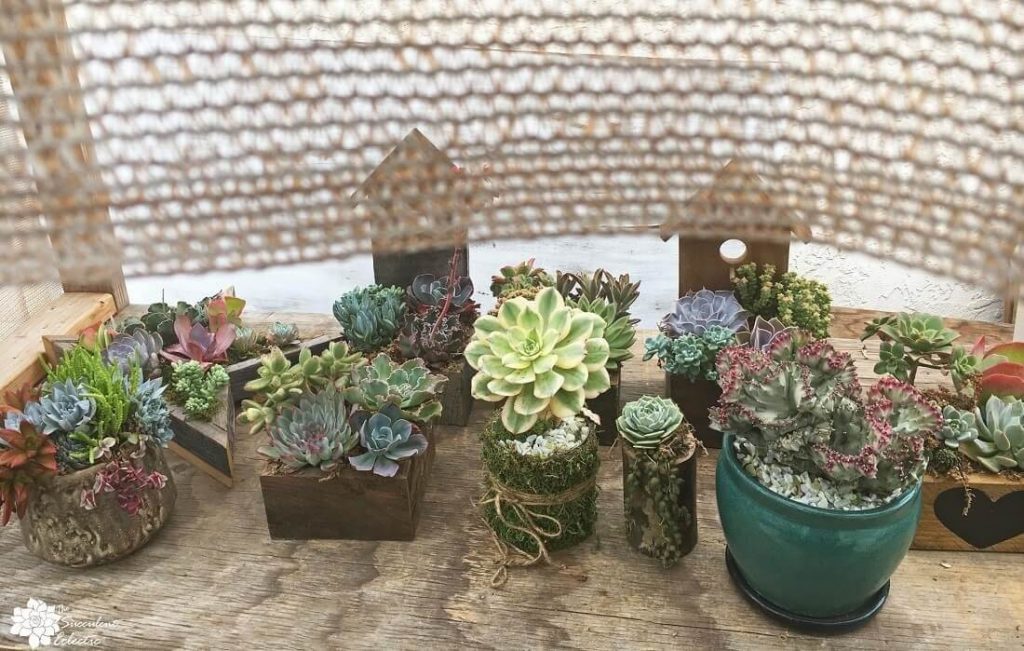
How much light do succulents need? As much as they can get without burning.
I know you’re frustrated that I am not giving you firm answers like “6 hours of direct sun”. Succulents just don’t work that way in nature. But there is one way they can — under shade cloth. Shade cloth gives me my succulent superpower! It is designed to filter the sun, casting shade that still allows sufficient light to filter through to keep plants healthy and happy. It also filters out most of the UV rays that burn your plants. Shade cloth comes in a variety of different colors and densities, ranging from 5% – 95% light blocking. All shade cloth dramatically cuts UV rays and casts shade 10-15 degrees cooler than full sun. Choose the density of sun-blocking you want first (35% – 75% for succulents) then select the color that appeals to you.
Shade cloth is a succulent lover’s best friend in fiercely hot climates as well as for those who are struggling to get the lighting for succulents right in their garden.
I’ve now given you a number of answers to the important question: How much light do succulents need? We’ve considered “enough light to maintain a compact growth habit” and “as much as they can get without burning”. But the way I grow my succulents is to rely on the plants themselves telling me what they need. I love hearing that you are talking to your succulents. I hope this post and the infographic will help you to listen to your succulents as well and to get the lighting right! If you have any questions, please let me know! Please take a moment to leave me a comment. I will get right back to you!
Happy gardening!

P.S. For more great succulent information, please subscribe to The Succulent Eclectic! I’ll send you my free e-course, 7 Steps to Succulent Success! Thanks!
P.P.S. Why not join my Facebook Group for succulent lovers? We talk about succulent care, propagation, succulent identification, and design. It’s a warm and welcoming group that would love to meet you!
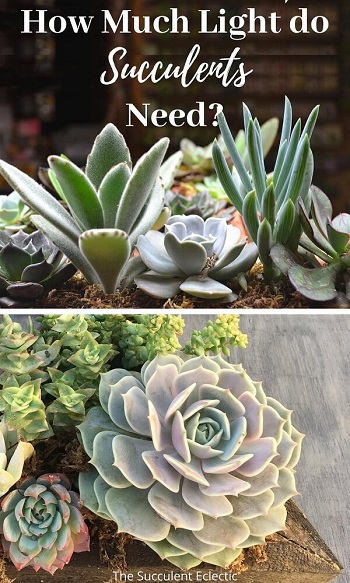
![You are currently viewing How Much Light do Succulents Need? + [Infographic]](https://thesucculenteclectic.com/wp-content/uploads/2020/10/how-much-light-do-succulents-need.jpg)



